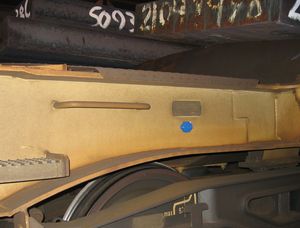In an effort to improve oversight of its production process Swedish Steel is using a radio frequency identification system to monitor the shipment of steel slabs. In April, the steelmaker began mounting active RFID tags to some 400 railcars used to transport steel slabs from its facility in the city of Luleå to one in Borlänge, about 900 kilometers away, and also from a facility in Oxelösund. The system is helping the company make sure that the right cars are being loaded with the correct materials, as well as identify the cars’ locations.
Swedish Steel is using custom-designed active RFID tags and readers from Swedish systems integrator and technology provider Adage Solutions. Sometime this month, the tagging of the 400 freight cars will be complete. Integration of the system’s software will begin in September.
Every car is being fitted with two tags—one on the front right side, the other on the back left—so that an interrogator can read a car’s tag regardless of the direction in which it is traveling. Each tag is encoded with its own unique ID number and the wagon number of the freight car to which it is attached.
The system features seven different points where the tags are interrogated—two in Luleå, two in Oxelösund and three in Borlänge. When a car is loaded in Luleå or Oxelösund, a reader mounted on a pole at the station interrogates its tag, and the tag ID number and wagon are recorded in a database and linked to a description of the slabs being shipped. When the train leaves the site, a pole-mounted reader in the rail yard records the car’s departure. At the facility in Borlänge, two readers along two separate train tracks log the freight car’s arrival. A third reader, mounted at the receiving station, notes when the car is unloaded.
The tag stays dormant until awoken by a 125 kHz signal. Once awake, it uses the 855 MHz UHF band to transmit its ID number and the freight car’s wagon number. Without volume discounts, each tag sells for roughly 60 euros, says Anders Hermanson, a sales manager for Adage.
“I don’t want to reveal any company secrets,” he says, “but I can say that active tags are one cornerstone of our solution as well as using magnetic fields to wake up the tags on the 125 kHz frequency.”
Swedish Steel tested some other RFID systems, but the read distances were shorter than 1 meter, which was not long enough. The company then contacted Adage, which sells active tags offering a read range of up to 10 meters.
Adage encountered a few problems while implementing the system. Hermanson explains that because the railcars are always in use, it took much longer than expected to get them into the shop so that tags could be mounted. Another challenge was Swedish Steel’s requirement that a tag has a lifespan of at least 10 years. Hermanson says that his company designed the tag so that it would deactivate itself and stay that way until it received a 125 kHz wake-up signal, thus saving battery power.
“When the tag is sleeping, it is not using any power at all,” he notes. “It’s the same as the battery would use through self-leakage. We solved the two problems—battery life and read range—by developing our own tags and readers.”
The RFID system, which cost the company about 100,000 euros, is helping Swedish Steel manage the flow of materials and plan production more efficiently. “They are counting their ROI in months,” Hermanson says.



